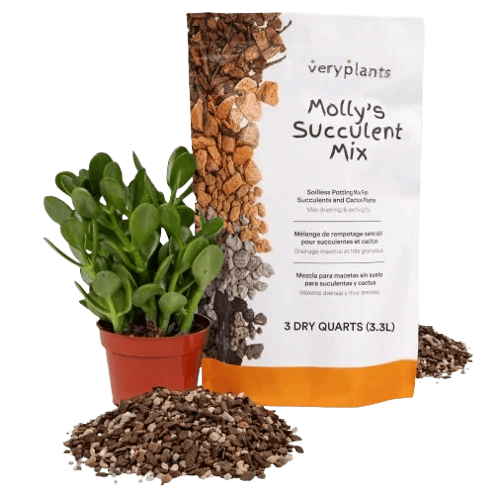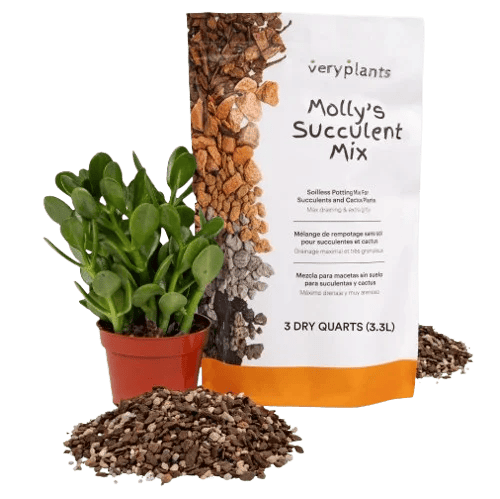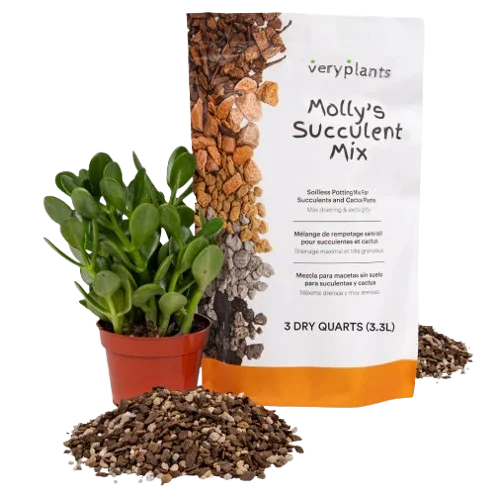Pests are, obviously, a part of nature and every houseplant owner will, at one time or another, have to deal with them, so if that’s you today don’t worry – you’re not alone – and pests can be managed with a little work and effort. Let’s dive into some common houseplant pests and best practices for managing them.
Aphids
Aphids are small, sap-sucking insects that cluster on plant stems and the undersides of leaves. Aphids are soft-bodied insects and come in a variety of colors, including peach, green, and black. Often, the noticeable remnants of their cast-off skins (appearing as white specks) and the secretion of honeydew (a sticky, clear substance) are more visible than the aphids themselves. Their soft bodies make them somewhat more susceptible to control compared to other pests, however. You can try spraying plants outdoors with a forceful stream of water or using a soapy water solution. Ensure thorough coverage, including the undersides of leaves. The use of insecticides is rarely needed.
Mealybugs
Mealybugs are oval-shaped insects with a peach-colored appearance, often concealed beneath a soft, cottony covering. This protective covering serves to shield both the adult mealybugs and their eggs from the effects of pesticides. Mealybugs are really good at positioning themselves within plant crevices, such as leaf axils and the undersides of leaves. In cases where the mealybug population is small, you can easily swab each insect with a cotton swab dipped in isopropyl alcohol. For larger populations, try hosing them down outside. Adjust the water stream to a gentle pressure and direct it specifically at the insects, taking care not to harm the plant. Similar to dealing with scale, diligence and repeated efforts will likely be required to get rid of mealybugs.
Scales
Scales use protective coatings as a means of protecting themselves from enemies. Two common varieties are typically encountered on indoor houseplants;
- Soft scales cover themselves in a waxy secretion. Soft scales are circular, flat, and exhibit a light brown or cream-colored appearance. They feed on the undersides of leaves and along stems. Their feeding activity leads to the formation of chlorotic spots on leaf surfaces and along stems, as they draw chlorophyll from the plant.
- Armored scales are oval-shaped insects with a dark-brown shell. Typically, they are found in a neatly-formed line on plant stems.
Scales lack wings and rely on crawling for movement, so keeping plants spaced apart can make it hard for them to move from one plant to another. Scales can be removed with a pressurized stream of water, or manually with a soft toothbrush dipped in isopropyl alcohol. If you have a ton of them, try horticultural soap or oil as directed on the product label. Scales may require multiple treatments to remove but be patient and persistent.
Spider mites
Spider mites are actually arachnids (not insects) and are related to spiders. They suck chlorophyll from plant cells, mainly from the underside of leaves, resulting in the appearance of tiny spots on the upper leaf surface. When their population is really big, they’ll start to feed on the upper leaf surfaces and growing tips. During this phase, you may notice the presence of small, delicate webs at the growing points. Spider mites love dry environments, so misting infested plants regularly can get rid of them. It’s important to do the misting outdoors to prevent the mites from relocating to other indoor houseplants. If a plant is really infested with spider mites you’re probably better off throwing it out (unfortunately) because large infestations are nearly impossible to come back from.
Thrips
Thrips are really small, slim, brown insects that love to tunnel into immature growing tips and flower buds. They feed on the delicate tissue, pollen, and petals. Their presence often leads to various forms of damage, including brown, distorted, and unsightly flower petals, as well as twisted leaf growth and chlorotic streaks on leaf surfaces. While thrips primarily target flowers for their feeding, there are instances where they infest the foliage of houseplants, causing necrotic leaf tissue and holes in the leaves. To effectively manage a thrips infestation, it is advisable to remove all infected flowers, buds, and plant debris, and dispose of them properly. You can also employ sticky cards to trap adult thrips. In severe cases of infestation, it may be necessary to consider using a registered bacterial insecticide as a control measure.
How to Prevent Pests in Your Home and Garden
An ounce of prevention, as they say 🙂, so what can you do to prevent plant pests from coming into your home in the first place? While it’s unlikely that you’ll never have a pest problem with your houseplants, here are a few easy things you can do to minimize the likelihood of uninvited guests finding their way into your house;
- The first thing you should always do is quarantine newly-purchased plants. That means keeping them separate from your other houseplants for a couple of weeks until you can be sure that they aren’t hosting a pest party.
- Regularly check your plants for the signs of pests (since oftentimes the pests themselves aren’t immediately visible). This means checking the leaves (front and back) as well as plant stems and flowers. At first sight of anything unusual, quarantine the plant until you figure out what the pest is and how to get rid of it, minimizing the likelihood of cross-infecting neighboring plants.
- Let your plants dry out between waterings. The majority of plant pests like moist environments within which to plant their eggs. Letting the potting mix dry between waterings can reduce the chances that pests will find a happy home for themselves. Note that this doesn’t generally apply to spider mites which prefer a dry environment but they’re an exception to the rule.
- Give your plants a shower every month or so. Putting your plants underneath the kitchen tap (if the plant is small) or shower (for bigger plants) not only serves as a thorough watering – it also cleans the leaves (so much dust build-up at home!) and dislodges pests, so a win for you and your plants!





I’ve used another super popular aroid mix but this one is FAR superior to it and contains much less FILLERS than that one does. This is a beautifully chunky mix that is IMPOSSIBLE to overwater and I absolutely love it. Also, it’s cheaper per quart than the other is. Molly’s all day!
Write a review HEHEF
I absolutely love this mix! I learned about it on a YouTube channel and thought I’d try it out with the multitude of jade plants I have. What is immediately amazing– I don’t need to use extra support to hold these top-heavy, dense plants up!! We will see with time, how the plants react, but so far– love it.